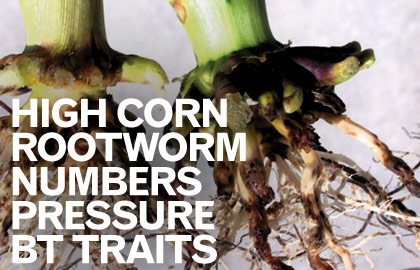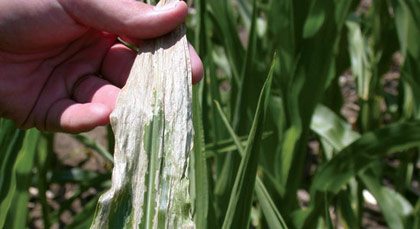Although Bt technology is holding its own, experts agree that best management practices and an integrated pest management strategy will play a big role in the durability of Bt traits.
High insect pressure means more crop damage and more pressure on existing technologies such as the Bt traits used to control corn rootworm. Management practices, such as continuous corn rotation, play a role in increasing insect populations, such as that found in some U.S. fields. Hot and dry summer conditions in combination with mild winters, in many areas, have also exacerbated this situation.
“We did see a higher level of corn rootworm pressure overall and earlier than normal this season,” says Luke Samuel, corn traits manager at Monsanto. “Environment plays a large role in what we see as far as insect pressure, and this past year there were a lot of factors that lined up to create a high-pressure year.”
Assessing the Situation
A 2011 study led by Iowa State University’s Aaron Gassmann entitled Field-Evolved Resistance to Bt Maize by Western Corn Rootworm reports that fields with severe rootworm feeding injury to Bt corn contained populations of western corn rootworm that “displayed significantly higher survival on Cry3Bb1 maize in laboratory bioassays than did western corn rootworm from fields not associated with such feeding injury.”
In addition, all fields with severe rootworm damage contained Cry3Bb1 maize. Researchers found a significant correlation between the number of years the Bt corn had been grown in a field and the survival of rootworm populations on Cry3Bb1 maize in bioassays.
The researchers did not find increased survival of these corn rootworm populations on Bt corn hybrids expressing the Bt toxin Cry34/35Ab1, which can be found in Herculex RW, Herculex Xtra and Genuity SmartStax hybrids. Products containing the Bt toxin Cry3Bb1 include YieldGard VT Triple, Genuity VT Triple PRO, and one of two Bt components found in SmartStax hybrids.
The researchers concluded that this study was the first report of field-evolved resistance to a Bt toxin by the western corn rootworm, and by any species of Coleoptera. The report suggests that insufficient planting of refuges and non-recessive inheritance of resistance may have contributed to the issue, and improvements in resistance management and a “more integrated approach to the use of Bt crops may be necessary.”
Monsanto has been actively working with farmers to adopt best management practices for corn rootworm management. Monsanto agronomists and dealers have been out in the fields again this year, working with farmers who experienced heavy corn rootworm feeding in Bt corn fields in 2011, to help them implement appropriate management strategies.
“Corn rootworm resistance is suspected in a number of isolated fields across the Corn Belt,” says Danielle Stuart, a spokesperson for Monsanto. “We are working with those growers to understand the situation and implement the appropriate integrated pest management strategies. The vast majority of farmers continue to have great success with our products.”
“Farmers who choose to plant corn-on-corn need to ensure they understand the importance of integrated pest management practices when managing high corn rootworm populations on-farm. We hosted corn-on-corn clinics this summer discussing the agronomic challenges of corn-on-corn production and obviously insect management is a key piece, as well as fertility, disease and residue management. So we have been talking with growers from many different perspectives.”
Western corn rootworm adult feeding on corn leaves in Cass County, Illinois, June 2012.
Integrated Solutions
Monsanto says that its Bt technology provides an exceptional level of value for farmers, especially when farmers employ best management practices in areas where corn rootworm pressure is highest.
“Even under all the pressure that we have found this year due to the environment and the other factors, Genuity SmartStax RIB Complete continues to look excellent,” says Samuel. “As we talk to growers who have experienced corn rootworm feeding on single mode-of-action products in the past, this season Genuity SmartStax RIB Complete has held up extremely well. We continue to emphasize the use of best management practices to help farmers be successful next year. We recommend they rotate to soybeans to break the corn rootworm cycle or move to a Genuity SmartStax product to handle those high pressure acres and use an integrated pest management system to maximize their yield potential.”
Monsanto now offers a complete line of Genuity RIB Complete options for insect protection. It’s important that retailers and their grower customers first understand the level of insect pressure on the farms and then choose the appropriate product to deal with it, says Samuel. “We take an integrated approach and we want growers to be successful, and part of that is using the right trait for the pressure that they see on their acres,” says Samuel.
Corn rootworm pressure is highest in areas where continuous corn crops are grown. Diversifying the rotation with crops such as soybeans to help break the cycle of infestation is usually the first line of defense most entomologists recommend. There are also other options, such as switching to hybrids that express another Bt trait; for example, Cry34/35Ab1, found in products like Herculex RW and Herculex Xtra. Alternatively, growers can use a product with dual modes of action like Genuity SmartStax.
Stacked traits, which express both the Cry3Bb1 and the Cry34/35Ab1 toxins, are also good options in areas of high rootworm pressure where the risk for development of resistance in the population may be higher.
There is concern, however, about the long-term effects of putting too much pressure on a single but effective trait. “My concern with the use of those pyramided hybrids in areas where resistance has been confirmed is that in effect you have really only one protein, the Cry34/35, that is working to provide the rootworm protection,” says University of Illinois extension entomologist Michael Gray. “You are putting a lot of selection pressure on that Cry34/35 protein, which is a pivotal protein in a lot of the hybrids that we have out there right now and we hate to lose that protein.”
“You are putting a lot of selection pressure on that Cry34/35 protein, which is a pivotal protein in a lot of the hybrids that we have out there right now and we hate to lose that protein.” — Michael Gray
Keeping existing technologies strong and viable for the long term is why experts in the industry agree that an integrated pest management strategy is crucial for the durability of the traits, and they encourage farmers to try different control options as well as diversifying crop rotations to protect their crops and their bottom lines.
More and more producers are opting to use a seed treatment in addition to the Bt trait for some extra insurance, says Lou Buice, president of Golden Acres Genetics. “I think more growers are choosing to layer the corn rootworm trait with additional seed treatments to give them a little extra protection,” he says. “We have certainly seen an increase in the number of growers booking insecticide protected seed for the 2013 season. With such a high value commodity, producers want to avoid unnecessary risk and it’s a fairly low cost on the front end for additional protection and peace of mind.”
Also playing into that decision, says Buice, is the fact that the southern states are seeing more problems with species other tha
n western corn rootworm. “Where producers do have rootworm problems year in and year out, and where they don’t do as much rotation, we have seen additional pressure from southern corn rootworm for the last couple of years. For now, there’s no trait that controls that particular species,” he says, “but the added seed treatments can be very effective.”
Trait Durability Challenged
The Bt trait has been around since the mid-1990s, and remains highly successful against other insects such as the European corn borer. It began to be widely used against corn rootworm around 2003, so why is the durability of the trait now being challenged?
There are two main factors, says Gray—the way in which refuges have been deployed and the effectiveness of the dose of the Bt toxin against different insect species.
“Bt hybrids used to control European corn borer are high dose events,” explains Gray in a video interview posted on the University of Illinois website. “When the insect is feeding on it there is a very high kill rate. That’s why producers have been very pleased with the technology, because it has been so effective against European corn borer.” Bt hybrids for corn rootworm, however, are low- to moderate-dose events, which means there are survivors in each field every year.
In addition, the refuge strategy for European corn borer, which has traditionally been a 20 percent refuge structure, which may be a separate field or block of a field planted with a non-Bt hybrid, works well with a high-dose event because of the mating and dispersal characteristics of the corn borer.
“But we know that for corn rootworm that kind of refuge structure doesn’t work as well because of the in-field mating soon after emergence and their subsequent dispersal patterns,” says Gray.
That’s the reason why the industry is rapidly moving towards a refuge-in-a-bag approach—as a more effective refuge management strategy. Monsanto has just implemented refuge-in-a-bag for all of its Genuity corn products.
“Stewardship is critical for us and it’s very important to make sure that refuge is out there,” says Samuel. “Refuge-in-a-bag ensures the refuge is being planted and it’s extremely convenient. Farmers can have peace of mind knowing they are in compliance and doing the right thing for the longevity of the trait.”
There is still some concern among entomologists that the five to 10 percent seed blend available in the refuge-in-a-bag product may not be high enough in areas with high rootworm pressure. “Although we know a refuge-in-a-bag approach is probably a preferred management strategy because of rootworm biology, in areas where resistance has been confirmed there is a concern about dropping the refuge from what it had been at 20 percent to five or 10 percent,” says Gray.
Working Together
Producers, industry, regulatory bodies and researchers are all working together to try and find better strategies to deal with corn rootworm challenges in Bt corn hybrid fields, and to maintain viable and effective control mechanisms for the long term.
“We are working very closely with farmers, agronomists and academics,” Stuart says. “From an industry perspective, we all have the same goal and that is to have durable Bt traits out on the marketplace that provide economic and sustainable products for farmers.”
Angela Lovell











